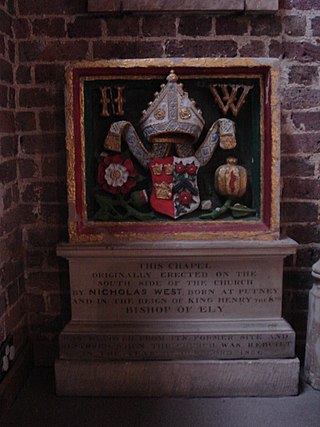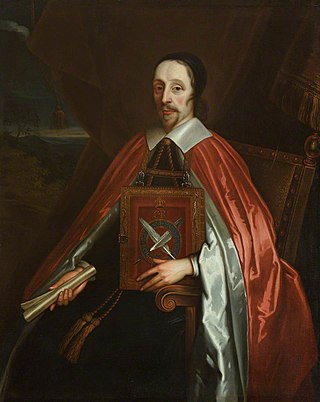Related Research Articles

Richard Neile was an English churchman, bishop successively of six English dioceses, more than any other man, including the Archdiocese of York from 1631 until his death. He was involved in the last burning at the stake for heresy in England, that of the Arian Edward Wightman in 1612.
The Dean of the Chapel Royal, in any kingdom, can be the title of an official charged with oversight of that kingdom's chapel royal, the ecclesiastical establishment which is part of the royal household and ministers to it.

Nicholas West, was an English bishop and diplomatist, born at Putney in Surrey, and educated at Eton and at King's College, Cambridge, of which he became a fellow in 1486. He also had periods of study at Oxford and Bologna.

Matthew Hutton was a high churchman in the Church of England, serving as Archbishop of York (1747–1757) and Archbishop of Canterbury (1757–1758).

The Choir of St George's Chapel at Windsor Castle exists to sing services in St George's Chapel at Windsor Castle.
Gerald Valerian Wellesley was a Church of England cleric who became the Dean of Windsor. More importantly, he was domestic chaplain to Queen Victoria and played a major advisory role regarding the royal family's personal affairs. He was one of the Queen's chief confidants and often served as an intermediary in her problems and conflicts. In Church appointments he was sensitive to the Queen's preferences: he avoided recommending the appointment of either High Churchmen or teetotallers. He tried to identify and place clergymen who were also high status gentlemen in key parish churches. He was politically nonpartisan, but was a friend of William Gladstone. He played a prominent advisory role in the ministerial crisis of 1880.
Ralph Brideoake (1612/13–1678) was an English clergyman, who became Bishop of Chichester.
William Wickham (Wykeham) was an English bishop.

John Fisher was a Church of England bishop, serving as Bishop of Exeter, then Bishop of Salisbury.

St George's Chapel at Windsor Castle in England is a castle chapel built in the late-medieval Perpendicular Gothic style. It is a Royal Peculiar, and the Chapel of the Order of the Garter. St George's Chapel was founded in the 14th century by King Edward III and extensively enlarged in the late 15th century. It is located in the Lower Ward of the castle.
Harry William Blackburne DSO, MC was an Anglican clergyman, Dean of Bristol from 1934 to 1951.
Lord Francis Seymour was a clergyman of the Church of England and a younger son of Edward Seymour, 8th Duke of Somerset. He was Dean of Wells from 1766 until his death.
Henry Bland was an English cleric.
James Denton was a Canon of Windsor from 1509 to 1533 Archdeacon of Cleveland from 1523 - 1533, and Dean of Lichfield from 1523 to 1532.
Samuel Haynes D.D. was a Canon of Windsor from 1743 to 1752.
John Mandeville was a Canon of Windsor from 1709 to 1722 and Dean of Peterborough from 1722 to 1725.

Christopher Wren B.D. was an Anglican cleric who was Dean of Windsor from 1635 until his death, and the father of the prominent architect Christopher Wren.
Samuel Pratt was a Canon of Windsor from 1697 - 1723 and Dean of Rochester from 1706 - 1723.
Simon Symonds M.A. was a Canon of Windsor from 1535–1551.
William Walesby was a Canon of Windsor from 1441 to 1450 and Archdeacon of Chichester from 1444 to 1444.